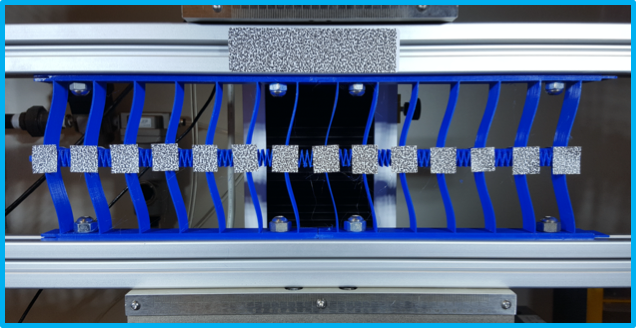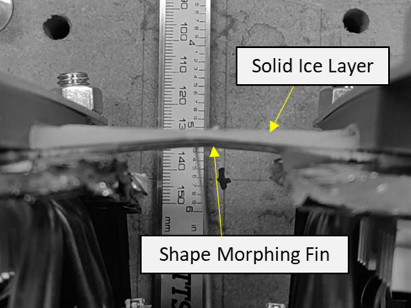Piezoelectric energy harvesters utilizing vortex-induced vibrations (VIV) have been extensively studied for converting wind energy into usable power for microelectronics. Traditional linear vortex-induced vibration (VIV) based energy harvesters comprise of a cantilevered beam with a piezoelectric transducer and a tip cylindrical bluff body to generate vortices under wind flow. When the vortex-shedding frequency matches the system’s natural frequency, large-amplitude resonant oscillations lead to high power output over a “synchronization” or “lock-in” region.
In this work, we explore the use of structural bistability to increase the range of flow speeds over which energy can be harvested without the need for complicated assemblies. We propose a harvester system featuring a piezoelectric transducer bonded to a cantilevered bistable composite laminate, which has two distinct equilibrium shapes at room temperature. To enhance the VIV, we attach a cylindrical bluff body to the free edge of the harvester. The structure’s inherent bistability allows for high power generation at two different flow speeds, contrasting with the single synchronization region typical of linear piezoelectric harvesters. We develop a reduced-order model to predict power output across varying flow speeds and validate these predictions through wind tunnel experiments, showing good agreement. Furthermore, we conduct a parametric study to optimize the model parameters for maximum power output.
The performance of conventional energy harvesters usually depends on the resonant frequency of the structures. The resonant frequency is inversely proportion to the size of the structure. Due to this, it is difficult to harvest energy in the low frequency range. However, many sources of the vibrations occurring around us possess very low frequencies. To solve this problem, we put forward the concept of soliton propagation which can be leveraged to harvest energy with broadband frequency irrespective of the size and mass of the structure.
In this study, we investigate an input-independent energy harvesting mechanism which is composed of discrete bistable unit cells. This mechanism exploits the topological solitary waves called transition waves. This system shows energy radiation in discrete bistable lattices and we numerically and experimentally show that the most dominant frequencies of these phonons are invariant to the input excitations as long as transition waves are generated. As a result, this mechanism offers very effective broadband energy harvesting that is not affected by the unit cell size and operating frequencies.

Vibration control has been a matter of intensive research for decades due to its omnipresence in different industries. For example, payloads need to be isolated so that they are not affected by the vibrations of the spacecraft. Over the years, several strategies have been developed for vibration damping. However, they have been found to be effective only for specific frequencies, while the vibrations may possess a wider range of frequencies. The present study focusses on developing a damping mechanism that is efficient for a wide range of vibration frequencies.
In this study, we explore vibration damping in a metastructure by allowing disturbances due to an external force to pass through a series a bistable units. Here, each unit is connected to a fixed frame through a bistable potential. Adjacent oscillators are connected through a linear spring. When the first unit is subjected to an external force of sufficient magnitude, it snaps and thereby causes subsequent units to snap, leading to a domino effect. In this manner, the chain of bistable units can allow transition waves to pass through them. The properties of these transition waves have been shown to be independent of the type and intensity of the external force by previous studies. Thus, by investigating how the properties (such as the mass, stiffness) of the chain affect the propagation of transition waves, we aim to provide an optimal design to damp vibrations of a wide range of frequencies and provide a stable structure for a payload mounted on the other end of the chain.


Frost formation in heat pump fin surfaces during cold climate conditions can significantly degrade the performance of air-source heat pumps. Typical thermal defrosting methods are energetically expensive and can cause thermal discomfort. This research investigates a novel mechanical defrosting solution for heat exchanger fins using multistable shape morphing cells integrated into the fins. Metal working is used to manufacture fins exhibiting multistable behavior (bistable and metastable) by plastically deforming selective regions of a laser-cut flat fin precursor. These structures undergo snap-through and suddenly release energy upon actuation, the induced out-of-plane displacements and vibrations can be used to break and shed frost. The mechanical defrosting approach on average consumes 81.09 less energy, requires 10.84 times less power and is 8.26 times faster.
The mechanical defrosting is highly effective for solid frost. The highly ductile nature of porous frost requires conversion to solid frost which can then be shed using a thermo-mechanical defrosting strategy.